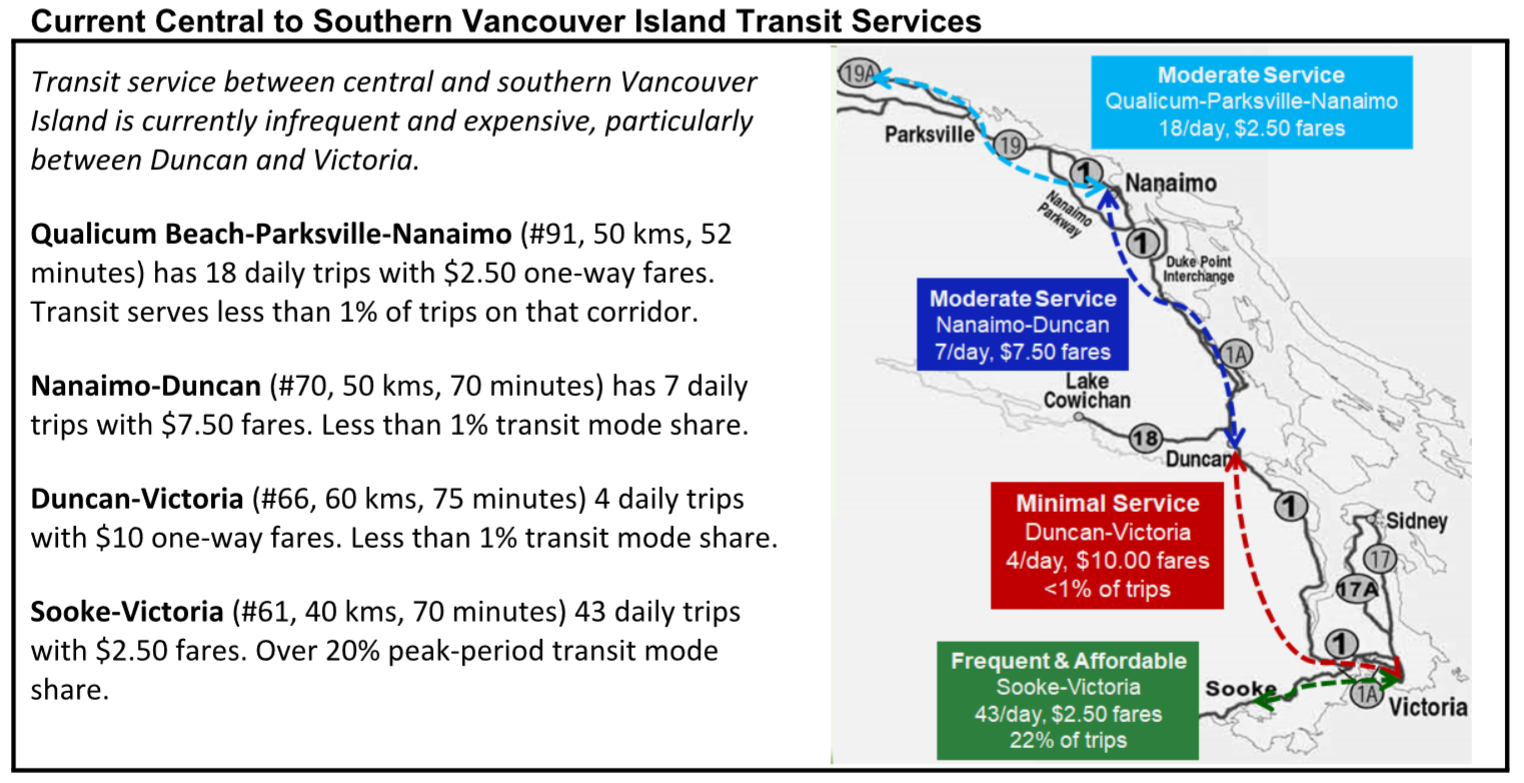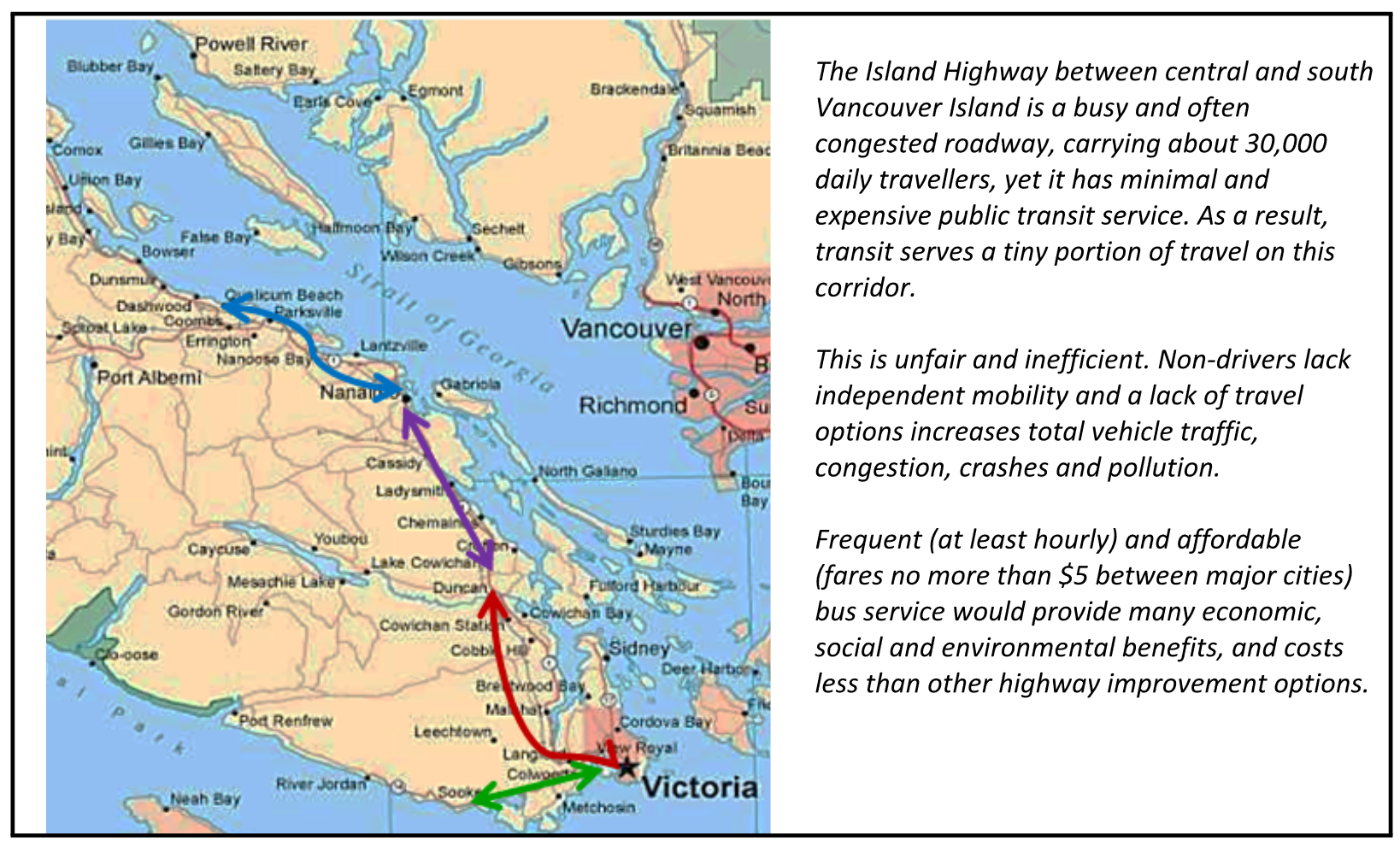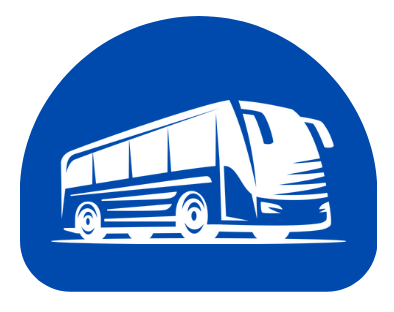Frequent and affordable public transit service can provide convenient independent mobility for travellers who cannot, should not or prefer not to drive on Island highways. It also reduces road congestion, crashes and pollution emissions. It supports local economic development by helping students access school, workers access jobs, businesses access employees and tourists access rural areas. It helps create more livable, equitable and successful communities.

Our short-term goal is to increase frequency and reduce fares for bus service between Duncan and Victoria (#66) and between Duncan and Nanaimo (#70). This will provide convenient and affordable public transportation from central Vancouver Island to Victoria and Sooke.
Island Highways Carries Roughly 30,000 people Per Day
It’s often congested, dangerous and sometimes closed due to crashes, flooding and rockfalls. It’s costly and environmentally damaging to expand, and it lacks mobility options for non-drivers. Every few years the provincial government develops proposals to reduce traffic problems on this corridor. These focus on costly roadway expansions, which only benefit motorists, or rail which would provide limited service with high fares. They give little consideration to frequent and affordable bus service.

Many community groups and local tribes oppose efforts to widen the highway through Gold Stream Park due to environmental concerns, and high-speed rail service that would impose noise and danger.
Transit Along The Island Highway Is Infrequent And Expensive
Between central and south Vancouver Island, transit service is currently infrequent and expensive. The Duncan-Victoria link has only four daily buses, with no reverse commute or off-peak service and $10 one-way fares.
- Qualicum Beach/Parksville/Nanaimo (#91, 50 kms, 52 minutes) has 18 daily trips with $2.50 one-way fares. Less than 1% transit mode share.
- Nanaimo/Duncan (#70, 50 kms, 70 minutes) has 7 daily trips with $7.50 fares. Less than 1% transit mode share.
- Duncan/Victoria (#66, 60 kms, 75 minutes) has only 4 daily trips with $10 one-way fares. Less than 1% transit mode share.
- Sooke/Victoria (#61, 40 kms, 70 minutes) has 43 daily trips with $2.50 fares. More than 20% peak-period transit mode share.
Provincial leadership is necessary to plan intercity public transit services that connect island communities. This would be a model for other intercity transit connections.
The Province Must Step Up And Fund Frequent, Affordable Transit
Provincial leadership will be integral to planning and funding frequent, affordable bus service between Duncan and Victoria and between Duncan and Nanaimo. This will provide convenient and affordable public transportation from central Vancouver Island to Victoria and Sooke. Specifically, we want the following:
- Develop a transit planning and funding agreement between Capital, Cowichan and Nanaimo regional districts, BC Transit and the MoTI.
- Provide hourly bus service between Duncan and Victoria from approximately 6:00am to midnight, with additional trips during weekday peak hours. Fares no more than two current regional fares ($5.00). Connect with Duncan-to-Nanaimo and Victoria-to-Sooke buses. Implement TDM incentives to encourage ridership.
This service would provide many benefits to users and communities, including benefits to motorists who experience less traffic congestion, crash risk and chauffeuring burdens. It also supports provincial targets to reduce personal vehicle travel by 25% and double walking, bicycling and public transit by 2030. It’s important to note that this is far cheaper and faster to implement than other proposed highway improvements.
We Will Keep Pushing For Better Transit On Vancouver Island
The Island Highway between Victoria and central Vancouver Island is a major congested and dangerous travel corridor. There are frequent calls for improvements to reduce driver stress, delays and crashes. Many travellers want an alternative to driving. Current demographic and economic trends are increasing demands for non-auto modes. Experience elsewhere, including Sooke-Victoria and Fraser Valley corridors indicate that this could attract 20-30% of travel. Frequent and affordable bus service with TDM incentives is by far the most cost-effective and beneficial way to improve mobility and reduce Island Highway traffic problems.
